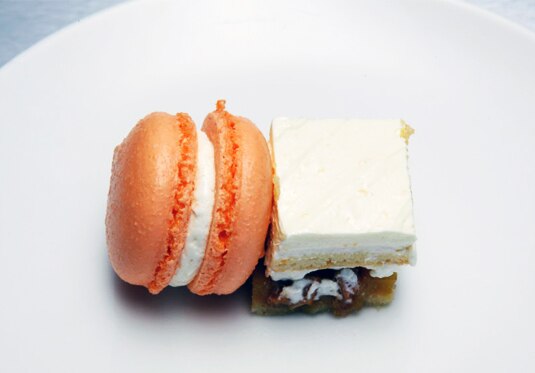
Create a free profile to get unlimited access to exclusive videos, sweepstakes, and more!
Macaron vs. Macaroon
Eli Kirshtein explains both confections' origins.

Who doesn’t love Macarons? With a crispy outer shell and a flavorful soft filling, they are a complete package. The modern version, also known as the Paris Macaron has a lineage tracing back to the 1533 arrival of Catherine De Medici to France. She brought an egg white and almond-based cookie called a Maccherone with her. Around the 1830s these evolved in to being served as miniature sandwiches filled with jams and jellies during tea parties. Then sometime later, around 1930, the confection part of the Macaron was refined to a petite meringue like cookie by pastry chef Pierre Desfontaines from the legendary Ladurée pastry shop in Paris. He then filled it with ganache and the current incarnation of the beloved pastry was born. There alternatively is another form of the pastry, known as a Macaroon. Deriving from Scottish tradition, they were first a mix of leftover mash potatoes and sugar loaf. After some years of refinement it changed to a mix of ingredient to form a crude version of fondant. In 1931, pastry chef John Justice Lees was making a chocolate fondant bar in which he botched the recipe terribly. Out of frustration and disgust, he added coconut to try salvage something. He ended up with the first Macaroon bar. This then evolved in two directions, the first into a cake-like coconut, and often dipped in chocolate, confection. And secondly into more candy-like items, you can even see the similar flavors and textures in modern-day Almond Joy and Mounds candy bars. The variations that are made of almond flour and egg whites also became particularly popular with Italian Jews. With no flour added they could then indulge in them during Passover in replacement of traditional Italian Amaretti.
Dulce de Leche is sweet, thick, unctuous goodness. It literally translates from Spanish to "milk candy." Basically, it is caramelized sweetened milk. In Latin countries it is traditionally made by slowly cooking milk and sugar while stirring constantly till it is reduced and thicken and a dark color is achieved. A simplified version is to take a can of sweetened condensed milk and to boil the whole can for two hours. As a disclaimer, if you decided to try to do this at home, completely chill the can in ice water after cooking to prevent a really painful episode. It is often formed into small caramel candies. It also has a very similar flavor to toffee due to its combination of dairy flavor and caramel. There are also several other versions all over the world including in Poland where a candy called Krówki is made in a similar way. In India a chilled version called Basundi is served with cardamom added for flavor.
Buttercream is essential for cake makers everywhere. With its richness, neutral color, and overall flavor, it’s a good blank media for decorating and garnishing. In its simplest form, buttercream is butter is whipped together with powdered sugar to form a smooth paste. Other recipes call for the addition of milk or even eggs, egg whites, or egg yolks. In the French version, sugar syrup is cooked to a thickened stage and then whipped with egg yolks to form a light froth, then soft butter is whipped in. Italian buttercream is fundamentally the same but uses egg whites instead of egg yolks. All of them have their pros and cons but they are all basically used for the same purpose, which is decorating pastries and confections. Many pastry chefs argue that it is too heavy and rich, but it still has an almost ubiquitous presence still in pastry.
Follow me on Twitter: http://twitter.com/elikirshtein


